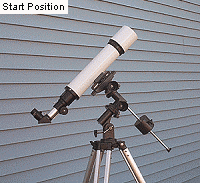 |
|
|
 |
|
|
|
Animated Equatorial Mount Tutorial
Introduction The most common sorts of questions about GEMs are "How do I point the telescope at [some part of the sky]?" Or, "Why is the telescope pointed at the ground when I try to view an object in the south?" There exist some excellent written descriptions of how a GEM operates, but it is a challenge to convey in words the operation of a moving mechanism. These pages are an attempt to pictorially illustrate the motions of a GEM. An equatorial mount, of which the GEM is but one variety, simplifies the tracking of celestial objects. The motions of the mount compensate for the rotation of the earth, allowing the observer to keep an object in view. With a properly aligned equatorial mount, the telescope need be moved in only one axis to track an object. The two axes of the GEM are known as Right Ascension (RA) and Declination (DEC). When the mount is polar aligned, moving the telescope in RA is all that's necessary to track a celestial object. Movement in both axes will likely be required to place an object in the eyepiece of the telescope, but once found, movement in RA alone will keep the object in view. When you click one of the links below, you'll see a stop-motion animation of a GEM in operation. All of the animation sequences begin with the telescope in the "Start Position" shown in the photo above. In this position, the telescope is aimed more or less at Polaris (the North Star). In the Start Position, the telescope is positioned directly above the mount.
Moving to View Near the Zenith |
